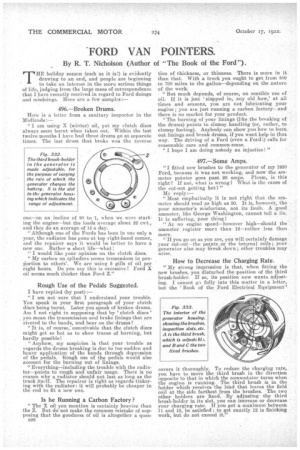'FORD VAN POINTERS.
Page 28

If you've noticed an error in this article please click here to report it so we can fix it.
By R. T. Nicholson (Author of "The Book of the Ford").
HE holiday season (such as it is!) is evidently drawing to an end, and people are beginning • to take an interest in the more serious things of life, judging from the large mass of correspondence that I have recently received in regard to Ford doings and misdoings. Here are a few samples :— 496.—Broken Drums.
Here is a letter from a sanitary inspector in the Midlands:— " I am using X (winter) oil, yet my clutch discs always seem burnt when taken out. Within the last twelve months I have had three drums an at separate times. The last drum that broke was the reverse one—on an incline of 20 to 1, when we were starting the engine—but the loads average about 22 cwt., and they do an average of 14 a day.
"Although one of the Fords has been in use only a year, the radiator has gone at top right-hand corner, and the repairer says it would be better to have a new one. Rather -a, short life—what!
"I would like your opinion on the clutch discs.
"My carbon on cylinders seems tremendous in profmrtion to otheis'. We are using 8 gills of oil per eight hours. Do you say this is excessive? Ford X oil seems much thicker than Ford Z."
Rough Use of the Pedals Suggested.
I have replied (by post) :— "I am not sure that I understand your trouble. You speak in your first paragraph of your clutch discs being burnt. Later you speak of broken drums. Am I not right in supposing that by 'clutch discs' you mean the transmission and brake linings that are riveted to the bands, and bear on the drums?
"It is, of course,' conceivable that the clutch discs might get so hot as to show traces of burning, but hardly possible!
" Anyhow, my suspicion is that your trouble as egards the drums breaking is due to too sudden and heavy application of the bands through depression of the pedals. Rough use of the pedals would also account for the burning out of linings.
"Everything—including the trouble with the radiator—points to rough and unfair usage. There is no reason why a radiator should not last as long as the truck itscAf. The repairer is right as regards tinkering with the radiator: it will probably be cheaper in the end to fit a new one.
Is he Running a Carbon Factory ?
"The X oil you mention is certainly heavier than the Z. But do not make the common mistake of supposing that the goodness of oil is altogether a ques tion of thickness, or thinness. There is more in it than that. With a truck you ought to get from NO to 700 miles to the gallon—depending on the nature of the work.
• "But much depends, of course, on sensible use of oil. If it is just slopped in, any old how,' at all times and seasons, you are not lubricating your engine ; you are just running a carbon factory—and there is no market for your product.
"The burning of your linings (like the breaking of the drums) points to clumsy handling (or, rather, to clumsy footing). Anybody can show you how to burn out linings and break drums, if you want help in that way. The driving of a Ford (even a Ford!) calls for reasonable care and common-sense.
'1 hope I am doing nobody an injustice 1 " 497.—Some Amps.
"I fitted new brushes to the generator of my 1920 Ford, because it was not working, and now the ammeter pointer goes past 20 amps. Please, is this right? If not, what is wrong? What is the cause of the cut-out getting hot?"
My reply:— " Most emphatically it is not right that the ammeter should read as high as 20. It is, however, the poor ammeter's misfortune, not its fault. A good ammeter, like George Washington, cannot tell a lie. It is suffering, poor thing ! " At no engine speed—however high—should the ammeter register more than 12—rather less than more.
"If you go on as you are, you will certainly damage your cut-out—the points or the internal coils ; your generator also may break down ; other troubles may arise.
How to Decrease the Charging Rate.
"My strong impression is that, when fitting the new brushes, you disturbed the position of the third brush-holder. If so, its position now wants adjusting. I cannot ge fully into this matter in a letter, but the 'Book of the Ford Electrical Equipment' covers it thoroughly. To reduce the charging rate, you have to move the third brush in the direction opposite to that in which the commutator turns when the engine is running. The third brush is in the holder which receives the lead that leaves the field coil at the side farthest from the brushes. The two other holders are fixed. By adjusting the third brush-holder in its slot, you can increase or decrease your charging rate. If you get a maximum between 11 and 12, be satisfied ; to get exactly 12 is finicking work, but do not exceed it."
































